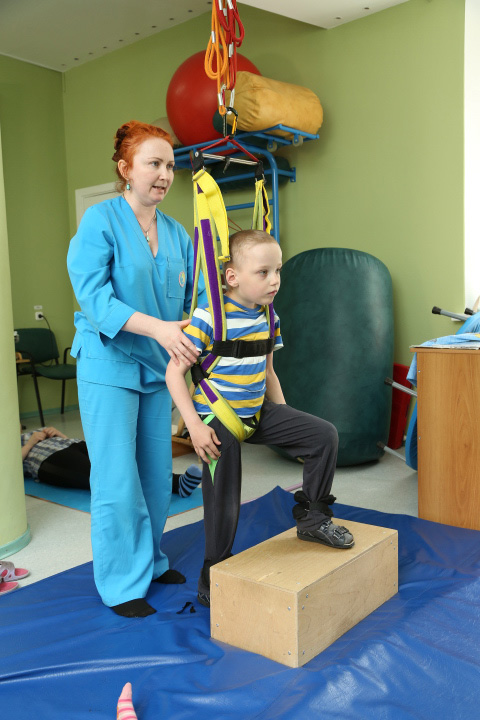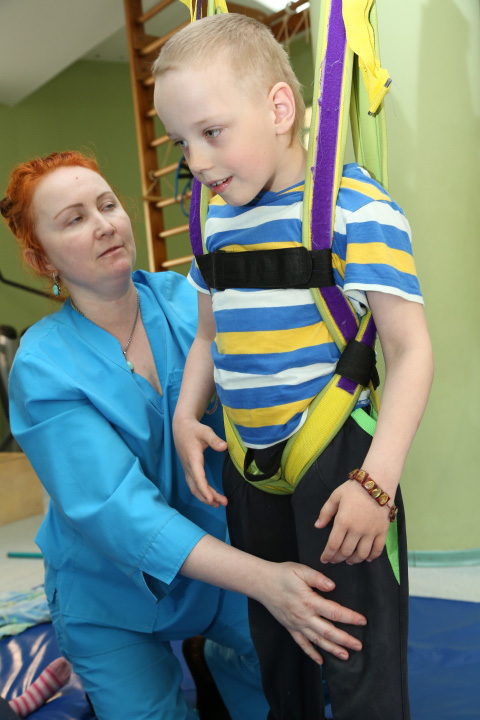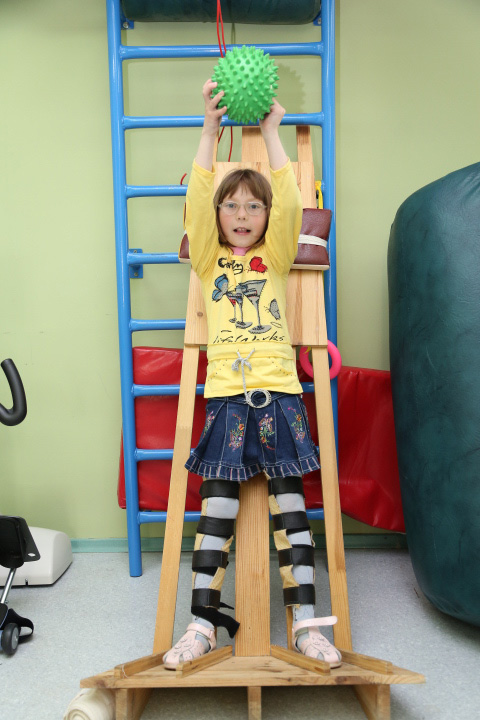Treatment base of the center includes many
(including copyright)
methods for the rehabilitation of disabled children with diseases of the nervous and musculoskeletal systems, the result of which are violations of the musculoskeletal system.Medical rehabilitation
In the first years of sick child, as in a healthy one formed a foundation of his psychophysical development, and an important role in this plays active motor regime. Because the normal development of the child and its individual systems is determined not only by hereditary factors, but also by motor activity that matched to the characteristics of the child's body in his age period
If the child is inactive from childhood and can`t acquire the necessary motor and social skills, it will be difficult for him to adapt to the social environment from the first year of his life.Because the environment requires significant psychological and physical stress. All this determines the functional inferiority of the neuromuscular system and leads to deformation of the extremities and the violation of the most important motor and static reactions, which limits the full development of the child. Defect of motor activity or its absence leads to negative changes in the body, which reduces the level of body`s adaptation in the environment and leads to a significant lag in social development.
The main limiting element of physical development is the restriction or lack of independent movement in an upright position, which prevents the maximum implementation of the recovery of the child. If a child in an upright position is not able to develop his movements independently or these movements are accompanied by many erroneous reactions, the development of motor skills does not occur at all or it happens uncorrectly. In addition, when someone takes a vertical position, motor locomotion becomes more complicated as body weight due to the transfer comes to the feet.
Treatment base of the center includes many (including copyright) methods for the rehabilitation of disabled children with diseases of the nervous and musculoskeletal systems, the result of which are violations of the musculoskeletal system.

Massage
Classic massage. Underwater massage- shower. Whirlpool baths. Bubble bath. Mineral, Aroma, medicinal baths.




Medicinal electrophoresis.
Medicinal electrophoresis.; electrophoresis. With preparation from curative mud , Paraffinotherapy and ozokerite.



Impulse electrotherapy
Impulse electrotherapy: measuring the dynamic characteristics of a step of walking person, amplipulse therapy, electrostimulation.



Local magnetotherapy
Local magnetotherapy. Magnetostimulation. Magnetophototherapy



Violet ray
Violet ray, EHF-therapy, Balneotherapy.



Light therapy
Light therapy: UV radiation, low-level laser therapy, bioptron therapy.




Reflexology
Reflexology: acupuncture, laser puncture, EHF-puncture.



Technical means of compensation
Technical means of compensation: wheelchairs, walkers, canes.


Gross simulator
Gross simulator helps children with lack of muscle function to do exercises more effective, doses the optimal load on the musculoskeletal system, provides normal joints mobility. The simulator allows to create conditions even for those children who do not have motor functions to perform various kinds of exercises in a natural vertical position and make movements in all planes of space (forward, backward, sideways, up and down). It gives the ability to rotate around axis without restricting movement arms, legs, and also insures against falling.
The simulator allows you to teach the patient voluntary movements and statics, as well as solve partial problems: relax the muscles in the presence of hypertonicity and hyperkinesis; stimulate the functions of weakened muscles and provide normal mobility in the joints. With the help of the simulator you can train the ability to measure and adjust spatial, temporal and dynamic parameters of movements and develop coordination abilities. You can promote the development of installation reflexes, on the basis of which movement is formed, which ensures sitting, standing, walking, spinning, cycling, rollerblading, performing elements of sports games.
The simulator allows you to restore the mobility of patients after severe spinal injuries, strokes, various diseases of the musculoskeletal system and cerebral palsy (cerebral palsy).
«Gross simulator» allows you to create conditions for the development of coordinated work of the musculoskeletal system, motility and stabilization of support ability which is necessary for the formation of a natural movement pattern and body position (i.e. those basics of motion control that are inaccessible to a patient with a pathology of muscle tone).
Lightened conditions are created for work for children with insufficient muscle function, and at the same time the simulator protects the patient from possible falls and injuries.
Using the simulator, you can move in space without any assistance while maintaining a vertical body position whether it is a living room, a hospital room, a training room, an outdoor sports ground or an ice arena. nbsp; The simulator provides an insurance for a variety of movements, turns with the body, inclinations, etc., which is important in the rehabilitation process. If the child does not hold his head, a special hat (individually adjustable) which is attached to the trapezium of the simulator, holds the head in the correct position without restricting the movement of the head.
The simulator kit includes elastic traction for legs (as an auxiliary element for performing stretching exercises and step movements) and hand rings.
The simulator allows you to perform exercises in both vertical and horizontal positions.
Adele’s costume
Adele's training costume is a modern effective rehabilitation tool for patients with motor disorders of cerebral origin (cerebral palsy, stroke, traumatic brain injury). He received the greatest application in the clinical practice of rehabilitation and treatment of patients with cerebral palsy (cerebral palsy).
The Adele costume is a power system that consist of supporting elements and elastic adjustable rods with the help of which is created a load on the musculoskeletal system of the patient for medical purposes. The suit is designed to correct the posture and patient`s movements.
The principle of action of the Adele’s medical costume consists in the formation of a powerful normalized flow of afferent impulse. Impaired functions are restored due to the directed correction of the patient’s posture and movements with the help of support and adjustable elements and the impact on the motor center of the brain.
It leads to the destruction of existing pathological synergies and the formation of new normalized reflex connections. It has a corresponding therapeutic effect on the structures of the central nervous system that control movements and speech.
With the help of the Adele medical costume can be achieved very high results in improving the patient's condition. Adele’s methods remain effective in the late stages of the disease, in which traditional methods have insufficient effect or do not have it at all. Techniques of "Adele" can be attributed to the best of the existing ones.
Medic massage
Medic massage has a direct effect on receptors located on the surface of the human body, and on deeper structures (muscles, blood vessels, internal organs). Properly selected technique helps to increase blood circulation and lymph outflow from internal organs and tissues, stimulates the release of biologically active substances into the blood that increase the body's defenses. A very important effect of medic massage is the normalization of muscle tone (i.e., with the use of various techniques, increased tone decreases and lowered increases). Lowering muscle tone for children with a spastic form of cerebral palsy means releasing the muscles of the limbs for further training.
Physiotherapy exercises - a set of treatment`s methods, prevention and medical rehabilitation, based on the use of physical exercises, specially selected and methodically developed. This is one of the most important elements of modern complex treatment. The main means of exercise therapy are physical exercises used in accordance with the objectives of treatment, taking into account the etiology, pathogenesis, clinical features, functional state of the body and the degree of general physical performance. Exercise therapy is the basis for the restoration of motor disorders in cerebral palsy., Exercise therapy in the RRCDC are specially developed for children with lesions of the nervous system, as well as unique physical rehabilitation systems known throughout the world.
Bobath therapy, Stacking (position treatment), Shield (position treatment)
Bobbat therapy refers to methods of active kinesitherapy. Includes:
1. Suppression of tonic reflexes and pathological patterns of movements by using various positions of individual parts of the body or postures of the whole body, which act as inhibitors of abnormal motility and muscle tone. This part of Bobath therapy is called “posture treatment.”
- Development of normal automatic and volitional movements based on reflex-inhibitory poses.
- Re-education of normal patterns of movement by linking physical exercises with normal sensory perceptions. The leading role is played by proprioceptive sensitivity, as well as tactile stimulation, a sense of position in the space of your body and its individual parts.
Stacking (position treatment)
The purpose of stacking is the elimination of pathological positions in one or more joints or a muscle group. Stacking and fixing (position) have a great importance for the formation of body patterns and movements. Preservation for a certain time of a given posture of the whole body and (or) parts of the body is an effective means of preventing or correcting vicious positions. Currently, in the practice of exercise therapy are used several types of Stacking.
Shield (position treatment)
The shield consists of two parts: a vertical wall and a horizontal platform for support. It is used to verticalize the body of the child. Used to eliminate contractures in the knee and ankle joints.
Balneological therapy, Physiotherapy
Balneological therapy
The active balneological procedure is an underwater shower - a massage that is usually prescribed for school-age children. The procedure consists of exposing the patient in a warm bath with a stream of water under a pressure of 0.5 - 4 atm. Underwater shower - massage is a successful combination of the influence of a warm bath and massage and is widely used to treat diseases of the musculoskeletal system.
Staying in warm water leads to relaxation of the muscles of the trunk and limbs. It makes a possibility to massage deeply located tissues with a jet of water. Improving local blood circulation provides the trophic, anti-inflammatory and relaxing effect of the underwater shower - massage. Children tolerate an underwater shower - massage well. After the procedure, there is a feeling of lightness, vitality, freshness, improves overall health.This condition is held for several hours.
Physiotherapy
Physiotherapy is a combination of methods for treating various diseases with the help of physical factors, such as electric current, magnetic radiation, heat, air, light and many others.Physiotherapy is an integral part of the rehabilitation period after severe injuries, as well as a lifesaver for chronic diseases of various organs.
Physiotherapy
Physiotherapy is a combination of methods for treating various diseases with the help of physical factors, such as electric current, magnetic radiation, heat, air, light and many others.Physiotherapy is an integral part of the rehabilitation period after severe injuries, as well as a lifesaver for chronic diseases of various organs. Physiotherapy develops active. There are many different methods today that can beneficially influence the body and whole and local problem areas.A qualified physiotherapist, using special equipment, selects treatment procedures according to the characteristics of the patient, his age and stage of development of the disease.
Physiotherapeutic procedures are usually painless and do not cause allergic reactions or other side effects.
However, most of them have contraindications, therefore, a consultation with a physiotherapist is necessary.
TOMATIS Method
In order to expand the rehabilitation opportunities for disabled children with disorders of the musculoskeletal system, the Center (at the expense of the UniHelp MBOO) trained specialists in the training using the TOMATIS method. During the training, they gained skills in working with TalksUp; two licensed TalksUp devices were also acquired in Europe and Russia. The TOMATIS method is a sensorineural sound stimulation method. It refers to the method of pedagogical influence.Areas of application are different: psychomotor impairment, speech development disorders, attention disorders, pervasive developmental disorder, learning problems, emotional and affective disorders, difficulties in social adaptation.
When teachers from the admissions committee accept a child, they introduce and explain information about the new pedagogical method of TOMATIS as a means of improving the quality of rehabilitation and social adaptation of disabled children into society. On the first days of the children’s arrival at the center specialists identify children who need who need to take a course based on the main clinical diagnosis, concomitant diagnosis, recommendations of the CCDER (Сenter of correction and development education and rehabilitation), age, individual characteristics. The procedure is prescribed only after consulting a doctor with a neurologist, in the presence of brain EEG for the last 6 months. There are certain contraindications: hydrocephalus, cancer, hearing impairment of more than 60%, epilepsy, a history of convulsive readiness. Teachers identified 9 children who need a procedure In May-June. Teachers hold talks with parents about the method of the procedure. At the end of the procedure were identified the goals and expectations of the parent. The experts were contacted by 8 parents, with whom were held initial consultations to collect information about the individual characteristics of the child. During the conversation, it turned out that the procedure is contraindicated for children.
Since September, 34 children underwent the procedure, including 6 children. who listened for to two- three programs. The selection of programs by specialists is carried out taking into account the individual characteristics and needs of the child, the request of the parents, the results of the previous program, children's capabilities. There are 10 listening programs of the first level: initial, basic, problems with emotions, speech, memory and attention. Each program consists of 13 music tracks. The music in each track is filtered by frequency depending on the task that is being pursued. The duration of each program is 26 hours for 13 days.
After the end of each program, the specialist conducts a compulsory conversation with the child and parents, a survey of parents. Interviews are also conducted with educators, defectologists, subject teachers and club leaders working with the child to identify the changes achieved or their absence. 24 children showed positive dynamics: self-confidence, desire to learn, increased self-esteem, motivation to study, improved behavior, dynamics in speech development, improved balance and coordination, increased ability to communicate, feel good, etc.
The TOMATIS method complements professional support and can significantly improve the results of specialists but it can not replace the work of specialists.
Social educator. 1st Level Specialist of the TOMATIS Methodology - Shnyp Lidiya Leonardovna

























